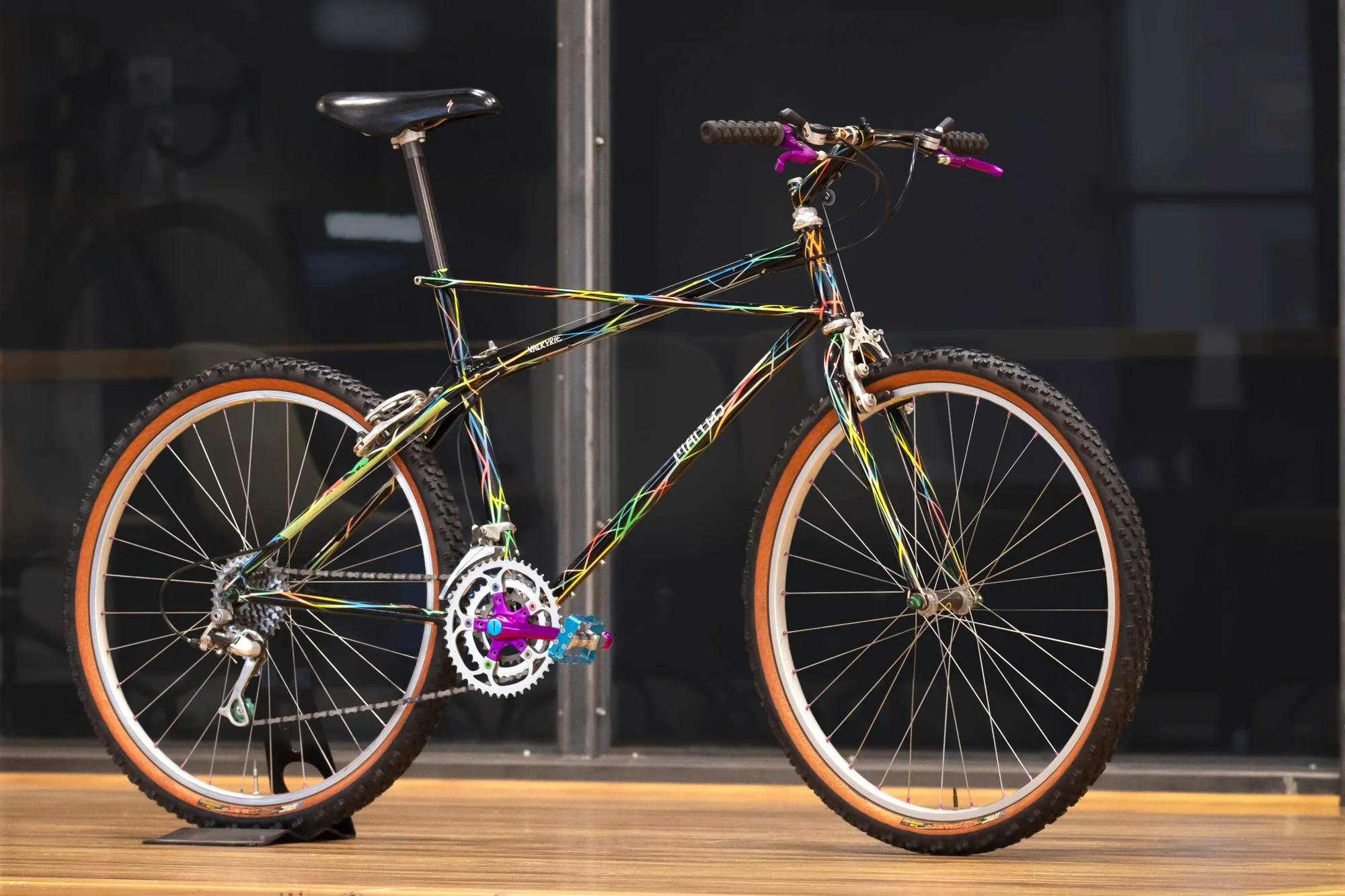Ever looked at a grainy black-and-white photo of your grandfather or grandmother and tried to pick out familiar features? Maybe the nose or the mouth? When the latest bikes roll into The Pro’s Closet’s facility, we have to wonder if they’re checking out the bikes in our museum, their ancestors.
Just like how you and I are more familiar with iPhone apps and Amazon than crank-starting a Model T or dancing the Lindy Hop, a bike in 2021 is worlds apart from one made in the late-’80s.
However, when a beautiful, rare Yeti ARC 35th Anniversary bike showed up at TPC, it got me thinking: Is this bike actually more similar to the original, legendary ARC than we might expect? Comparisons between modern and vintage are pretty common, but most seem to focus on differences, not similarities.
After a bit of research, I’ve turned up five notable similarities between today’s carbon fiber marvel and this 1992 Yeti ARC, beautifully restored by Second Spin Cycles.
SHOP MOUNTAIN BIKES | SHOP ALL BIKES
1. Yeti Frames: Always innovative
Although aluminum frames were ascendant in the early ‘90s, no one built them like Yeti. This ARC features the single-piece chain stay/seat stay assembly that gives Yeti hardtails that classic loop at the dropout. Features like that and the ovalized top tube stand out to the naked eye, but hidden beneath the paint are Easton Varilite tubes. Yeti was one of the first companies to use this radical taper-butted tubing, which led to a frame that was close to three pounds when anodized rather than painted.
SHOP FRAMES
In fact, that’s only a skosh heavier than the 2021 Yeti ARC built with Turq carbon fiber. Like its forefather, today’s ARC is innovative, but that comes through less in the frame material and more in the design. What was once a simple XC hardtail now features progressive geometry you’d find on a trail bike: steep 76-degree seat tube, slack 67-degree head tube, and generous reach.
2. Wide gearing, one way or another
Today’s “shredits” don’t usually feature much climbing footage, but just like riding in the early ‘90s, we still have to get to the top of the hill. Front derailleurs are now all but eliminated from mountain bikes (watch out roadies, you’re next!). The cassette on today’s Yeti ARC goes from 10 to 52 teeth. But believe it or not, that actually provides a gear range that’s quite similar to the Shimano Deore XT drivetrain found on the ‘92 ARC. Thanks to the gear calculator on the late, great Sheldon Brown’s website, I discovered the lowest gear on the old ARC, 24x30T, was 20.6 gear inches, just a few shy of the 32x52 combo on the modern bike, which clocks in at 17.8 gear inches. In fact, the ‘92 has a taller big gear at 95.1 gear inches for the massive 48x13T combo versus 92.6 gear inches when you’re in 32x10T. But which would you rather ride down the Kamikaze race track?
3. Wait… Weight is similar?
Despite the new Yeti’s Turq carbon frame and svelte SRAM XX1 build, it’s actually heavier than the 1992 ARC — 25.6 versus 22.3 pounds, respectively. Looking back at a review in the June 1992 issue of Bicycle Guide, I found that the Yeti ARC built with a Manitou fork actually weighed about 25.5 pounds. Now, the dropper post and Fox 34 fork undoubtedly add to the new Yeti ARC’s weight, but it would be much less fun without those add-ons. And really, that’s what mountain biking’s all about.
4. The prices are close, even if one may be “priceless”
Back in 1992, the going rate for a Yeti ARC frame and an Accu-Trax steel fork, as pictured, was $1,800. Today, a new Yeti ARC frame is priced at $1,900. Take into account a Fox Factory 34 fork at about $949, and you’ve got a $2,849 package. That seems like a lot more until you take inflation into account. In fact, in 2021 bucks, that 1992 Yeti ARC and Accu-Trax combo was right around $3,398.
But wait, $500 is a pretty significant difference! It is, but that modern-day ARC pricing doesn't account for the limited-edition livery. Although Yeti doesn't sell the 35th anniversary ARC as a frame-only option, you can extrapolate by comparing the complete bike pricing. The flashy colors are about a 20% up-charge. So by my estimates, you might say a modern-day special-edition ARC frame and fork will cost about $3,419. Voila!
5. Ano’ … Need I say more?!

The folks at Yeti really deserve credit for getting all the details dialed on this 35th Anniversary ARC. Pretty much every part that could be anodized is anodized — hubs, derailleur, chainring, stem, seat clamp, hardware, and more. It’s all brilliant turquoise. Of course, back in the late ‘80s and early ‘90s, ano’ purple was de rigueur, but no matter the color, it’s all about the flash.
Conclusion

Okay, maybe it’s a bit of a stretch to say that today’s Yeti ARC, or any modern bike, is all that similar to its predecessors from 35 years ago. I love vintage bikes, but modern mountain bike design is a wonderful thing. We now have purpose-built, capable bikes that are a far cry from the ‘90s rigs, which heavily relied on traditional road bike design philosophy and technology.
Whether you prefer to ride a new ARC or an old one is up to you. I’m just glad that Yeti is willing to pull out the family photo album and take us on a trip down memory lane every once in a while.
What is your favorite vintage bike that deserves a modern-day "anniversary" edition? Let me know in the comments!
























